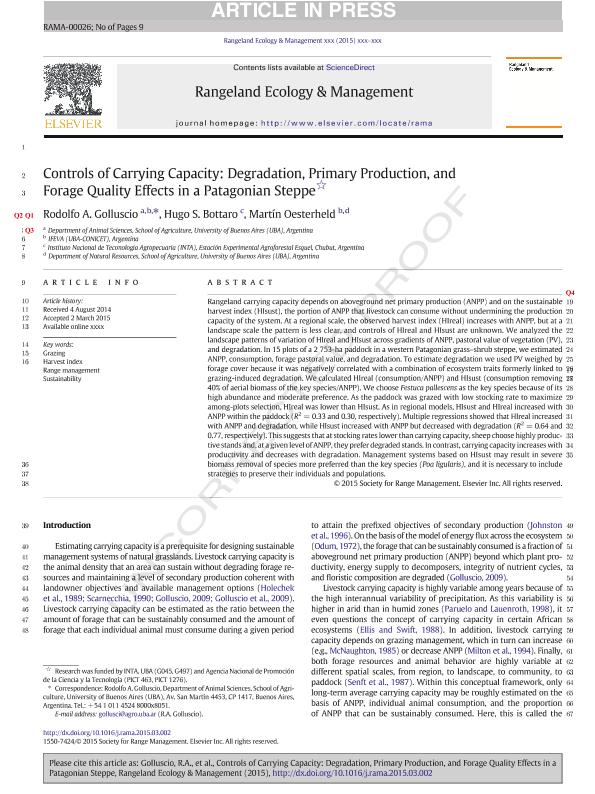Mostrar el registro sencillo del ítem
dc.contributor.author
Golluscio, Rodolfo

dc.contributor.author
Bottaro, Hugo S.
dc.contributor.author
Oesterheld, Martin

dc.date.available
2016-02-18T19:17:23Z
dc.date.issued
2015-05
dc.identifier.citation
Golluscio, Rodolfo; Bottaro, Hugo S.; Oesterheld, Martin; Controls of Carrying Capacity: Degradation, Primary Production, and Forage Quality Effects in a Patagonian Steppe; Society for Range Management; Rangeland Ecology and Management; 68; 3; 5-2015; 266-275
dc.identifier.issn
1550-7424
dc.identifier.uri
http://hdl.handle.net/11336/4270
dc.description.abstract
Rangeland carrying capacity depends on aboveground net primary production (ANPP) and on the sustainable 19harvest index (HIsust), the portion of ANPP that livestock can consume without undermining the production 20capacity of the system. At a regional scale, the observed harvest index (HIreal) increases with ANPP, but at a 21landscape scale the pattern is less clear, and controls of HIreal and HIsust are unknown. We analyzed the 22landscape patterns of variation of HIreal and HIsust across gradients of ANPP, pastoral value of vegetation (PV), 23and degradation. In 15 plots of a 2 753-ha paddock in a western Patagonian grass?shrub steppe, we estimated 24ANPP, consumption, forage pastoral value, and degradation. To estimate degradation we used PV weighed by 25forage cover because it was negatively correlated with a combination of ecosystem traits formerly linked to 26grazing-induced degradation. We calculated HIreal (consumption/ANPP) and HIsust (consumption removing 2740% of aerial biomass of the key species/ANPP). We choose Festuca pallescens as the key species because of its 28high abundance and moderate preference. As the paddock was grazed with low stocking rate to maximize 29among-plots selection, HIreal was lower than HIsust. As in regional models, HIsust and HIreal increased with 30ANPP within the paddock (R 31 2 = 0.33 and 0.30, respectively). Multiple regressions showed that HIreal increasedwith ANPP and degradation, while HIsust increased with ANPP but decreased with degradation (R 32 2 = 0.64 and0.77, respectively). This suggests that at stocking rates lower than carrying capacity, sheep choose highly produc- 33tive stands and, at a given level of ANPP, they prefer degraded stands. In contrast, carrying capacity increases with 34productivity and decreases with degradation. Management systems based on HIsust may result in severe 3536 biomass removal of species more preferred than the key species (Poa ligularis), and it is necessary to include37 strategies to preserve their individuals and populations.
dc.format
application/pdf
dc.language.iso
eng
dc.publisher
Society for Range Management

dc.rights
info:eu-repo/semantics/openAccess
dc.rights.uri
https://creativecommons.org/licenses/by-nc-sa/2.5/ar/
dc.subject
Grazing
dc.subject
Harvest Index
dc.subject
Range Management
dc.subject
Sustainability
dc.subject.classification
Agricultura

dc.subject.classification
Agricultura, Silvicultura y Pesca

dc.subject.classification
CIENCIAS AGRÍCOLAS

dc.title
Controls of Carrying Capacity: Degradation, Primary Production, and Forage Quality Effects in a Patagonian Steppe
dc.type
info:eu-repo/semantics/article
dc.type
info:ar-repo/semantics/artículo
dc.type
info:eu-repo/semantics/publishedVersion
dc.date.updated
2016-03-30 10:35:44.97925-03
dc.journal.volume
68
dc.journal.number
3
dc.journal.pagination
266-275
dc.journal.pais
Estados Unidos

dc.journal.ciudad
Boulder
dc.description.fil
Fil: Golluscio, Rodolfo. Consejo Nacional de Investigaciones Científicas y Técnicas. Oficina de Coordinación Administrativa Parque Centenario. Instituto de Investigaciones Fisiológicas y Ecológicas Vinculadas A la Agricultura; Argentina. Universidad de Buenos Aires. Facultad de Agronomia; Argentina
dc.description.fil
Fil: Bottaro, Hugo S.. Instituto Nacional de Tecnologia Agropecuaria. Estación Experimental Agroforestal Esquel; Argentina
dc.description.fil
Fil: Oesterheld, Martin. Consejo Nacional de Investigaciones Científicas y Técnicas. Oficina de Coordinación Administrativa Parque Centenario. Instituto de Investigaciones Fisiológicas y Ecológicas Vinculadas A la Agricultura; Argentina. Universidad de Buenos Aires. Facultad de Agronomia. Departamento de Recursos Naturales y Ambiente; Argentina
dc.journal.title
Rangeland Ecology and Management

dc.relation.alternativeid
info:eu-repo/semantics/altIdentifier/url/http://www.bioone.org/doi/abs/10.1016/j.rama.2015.03.002#fn01
dc.relation.alternativeid
info:eu-repo/semantics/altIdentifier/issn/1550-7424
dc.relation.alternativeid
info:eu-repo/semantics/altIdentifier/doi/http://dx.doi.org/10.1016/j.rama.2015.03.002
Archivos asociados
